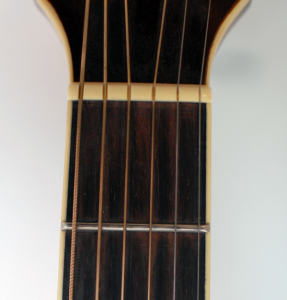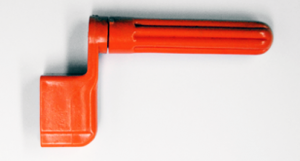
Before we jump into how to string a guitar, let’s first cover a few guitar string basics.
Use the Right Strings – Before you purchase a new set of strings for your guitar, make sure you know what type of guitar strings your guitar uses. Electric and steel-string acoustic guitars are built for using metal strings, but they use very different alloys and gauges. Classical and folk acoustic guitars are made for nylon strings, and, again, there are different types. Installing the wrong strings could ruin your setup or, worse, damage your guitar. Also thick guitar strings (medium and heavy gauge) are harder to hold down. For beginning guitarists it is usually best to start with lighter gauge strings, and go heavier as your hands get stronger.
Always Change Strings When They Are Worn – Guitar strings should be replaced regularly. As metal guitar strings age, they become corroded. Some last longer than others, but all guitar strings tend to lose their brilliance over time. If your guitar strings are really old or worn out, your guitar will sound dead and be more difficult to tune. Corroded strings can also be harder on your fingers.
What Tools Do I Need to Change Guitar Strings?
As you learn how to string a guitar properly, these basic tools will make it easier:
Strings
You will need a new set of strings that are appropriate for your guitar and style (see the list of guitar and string types below).

String Winder (String Crank)
An inexpensive string winder (or string crank) is indispensable. Without it, you’ll have to crank the guitar tuning key with your fingers — a very tiring task! Professional guitar shops have to change strings so often that they normally use battery-powered string winders. A standard guitar string winder usually features a special slot for pulling up bridge pins found on steel-string acoustic guitars. You’ll find a standard string winder in the eMedia Guitar Accessory Kit. These look similar to the pictures to the right. These tools crank on the guitar tuning key so that the string wraps around the tuning machine and gets tuned up to pitch faster.

Wire Clippers
You don’t absolutely need a wire cutter, but without it you’ll end up with long tails on the end of each string that get in the way when you’re changing the other strings. Some companies make string winders with integrated wire cutters (see photo). Most wire cutters, snips, or pliers with snips will do the job. When clipping the end off the string try to leave about 1/2 inch.

Steps for How to String a Guitar
For the step-by-step instructions on how to string a guitar like the one you own, please select the link below that corresponds to your guitar. These lessons will also have links to help you learn more about string types used for the individual guitar types.
How to String a Classical Guitar
Instructions for how to string a nylon string guitar. Useful for both classical and folk guitars.
How to String an Acoustic Guitar with Steel Strings
Here you learn how to change strings on a steel-string acoustic guitar. Be sure to read about acoustic guitar string types. Guitar string variations can greatly affect the sound and playability of your guitar.
How to Change Electric Guitar Strings
This gives you a great guide on how to string an electric guitar. To bend strings easier, select light gauge electric strings.
Tips for Changing Guitar Strings
Wash your hands before changing you guitar strings. Oils from your fingers make the strings corrode faster.
While your strings are off, you may wish to polish your guitar, particularly the neck and underneath where the strings are around the sound hole or pickups. You can remove the dust by wiping with a damp cloth. Remove dust by wiping with a cloth that has been sprayed lightly with guitar polish (also included in the eMedia Guitar Accessory Kit).